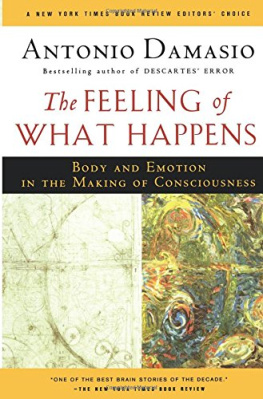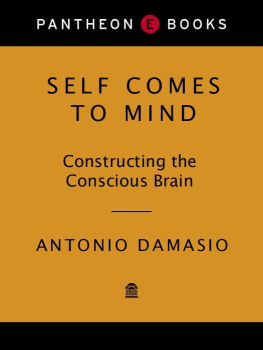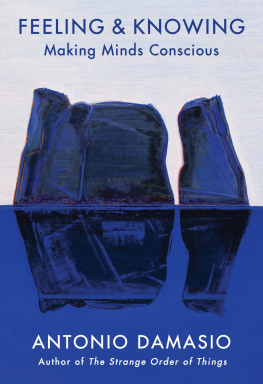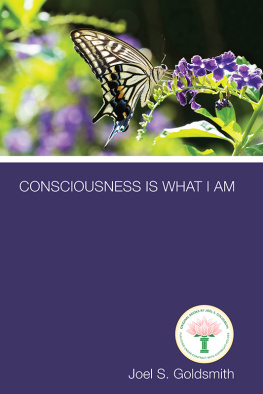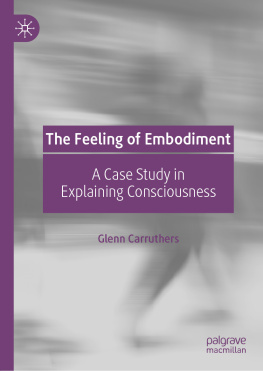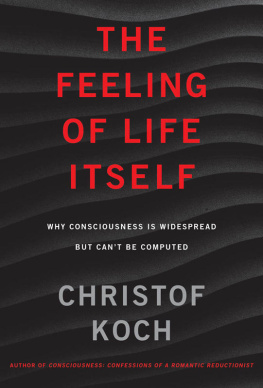It ft. -It r Jo author of DESCARTES' ERROR e LI AT dv and Emc of A rtion in the s aking of Consciousness
The Feeling of What Happens
The Feeling of What Happens i BODY AND EMOTION IN THE MAKING OF CONSCIOUSNESS Antonio R. Damasio HARCOURT BRACE & COMPANY New York San Diego London
Copyright 1999 by Antonio Damasio All rights reserved. No part of this publication may be reproduced or transmitted in any form or by any means, electronic or mechanical, including photocopy, recording, or any information storage and retrieval system, without permission in writing from the publisher. Requests for permission to make copies of any part of the work should be mailed to: Permissions Department, Harcourt, Inc., 6277 Sea Harbor Drive, Orlando, Florida 32887-6777. "Notes on the Reality of the Self" from Materialism by Jorie Graham. Copyright 1995 by Jorie Graham. Reprinted by permission of The Ecco Press. All figures courtesy of Dr. Hanna Damasio. Excerpt from "Dry Salvages" in Four Quartets, copyright 1941 by T. S. Eliot and renewed 1969 by Esme Valerie Eliot, reprinted by permission of Harcourt, Inc. Library of Congress Cataloging-in-Publication Data Damasio, Antonio R. The feeling of what happens: body and emotion in the making of consciousness/Antonio R. Damasio.1st ed. p. cm. Includes bibliographical references and index. ISBN 0-15-100369-6 1. Consciousness. 2. ConsciousnessPhysiological aspects. 3. Emotions Physiological aspects. I. Title. BF311.D33 1999 153dc2i 99-26357 Text set in Spectrum MT Designed by Lori McThomas Buley Printed in the United States of America First edition F
For Hanna
Or the waterfall, or music heard so deeply That it is not heard at all, but you are the music While the music lasts. These are only hints and guesses, Hints followed by guesses; and the rest Is prayer, observance, discipline, thought and action. The hint half guessed, the gift half understood, is Incarnation. T. S. ELIOT "Dry Salvages" from Four Quartets The question of who I was consumed me. I became convinced I should not find the image of the person that I was: Seconds passed. What rose to the surface in me plunged out of sight again. And yet I felt the moment of my first investiture was the moment I began to represent myself the moment I began to liveby degreessecond by second unrelentinglyOh mind what you're doing! do you want to be covered or do you want to be seen? And the garment how it becomes you!starry with the eyes of others, weeping JORIE GRAHAM "Notes on the Reality of the Self from Materialism
CONTENTS part i Introduction i chapter one Stepping into the Light 3 Stepping into the Light Absent without Leave The Problem of Consciousness Approaching Consciousness Mind, Behavior, and Brain Reflecting on the Neurological and Neuropsychological Evidence A Search for Self Why We Need Consciousness The Beginning of Consciousness Coping with Mystery Hide and Seek part 11 Feeling and Knowing 33 chapter two Emotion and Feeling 35 Once More with Emotion A Historical Aside The Brain Knows More than the Conscious Mind Reveals An Aside on Controlling the Uncontrollable What Are Emotions? The Biological Function of Emotions Inducing Emotions The Mechanics of Emotion Have No Fear How It All Works Sharpening the Definition of Emotion: An Aside The Substrate for the Representation of Emotions and Feelings chapter three Core Consciousness 82 Studying Consciousness The Music of Behavior and the External Manifestations of Consciousness Wakefulness Attention and Purposeful Behavior Studying Consciousness from Its Absence IX
x g-_^ Contents CHAPTER FOUR The Hint Half Hinted 107 Language and Consciousness If You Had That Much Money: A Comment on Language and Consciousness Memory and Consciousness Nothing Comes to Mind David's Consciousness Rounding Up Some Facts The Hint Half Hinted part in A Biology for Knowing 131 chapter five The Organism and the Object 133 The Body behind the Self The Need for Stability The Internal Milieu as a Precursor to the Self More on the Internal Milieu Under the Microscope Managing Life Why Are Body Representations Well Suited to Signify Stability? One Body One Person: The Roots of the Singularity of Self The Organism's Invariance and the Impermanence of Permanence The Roots of Individual Perspective, Ownership, and Agency The Mapping of Body Signals The Neural Self Brain Structures Required to Implement the Proto-Self Brain Structures Which Are Not Required to Implement the Proto-Self Something-to- BeKnown A Note on the Disorders of the Something-to-BeKnown It Must Be Me because I'm Here chapter six The Making of Core Consciousness 168 The Birth of Consciousness You Are the Music while the Music Lasts: The Transient Core Self Beyond the Transient Core Self: The Autobiographical Self Assembling Core Consciousness The Need for a Second-Order Neural Pattern Where Is the Second-Order Neural Pattern? The Images of Knowing Consciousness from Perceived Objects and Recalled Past Perceptions The Nonverbal Nature of Core Consciousness The Naturalness of Wordless Storytelling One Last Word on the Homunculus Taking Stock chapter seven Extended Consciousness 195 Extended Consciousness Assessing Extended Consciousness Disorders of Extended Consciousness Transient Global Amnesia Anosognosia Asomatognosia The Transient and the Permanent The Neuroanatomical Basis for the Autobiographical Self The
Contents -_-^> xi Autobiographical Self, Identity, and Personhood The Autobiographical Self and the Unconscious Nature's Self and Culture's Self Beyond Extended Consciousness chapter eight The Neurology of Consciousness 234 Assessing Statement Number One: Evidence for a Role of Proto-Self Structures in Consciousness It Looks like Sleep It May Look like Coma Reflecting on the Neural Correlates of Coma and Persistent Vegetative State The Reticular Formation Then and Now A Quiet Mystery The Anatomy of the Proto-Self in the Perspective of Classical Experiments Reconciling Facts and Interpretations Assessing Statement Number Two: Evidence for a Role of Second-Order Structures in Consciousness Assessing the Other Statements Conclusions A Remarkable Overlap of Functions A New Context for Reticular Formation and Thalamus A Counterintuitive Fact? part iv Bound to Know chapter nine feeling feelings Feeling Feelings The Substrate for Feelings of Emotion From Emotion to Conscious Feeling What Are Feelings For? A Note on Background Feelings The Obligate Body-Relatedness of Feeling Emotion and Feeling after Spinal Cord Transection Evidence from the Section of Vagus Nerve and Spinal Cord Lessons from Locked-In Syndrome Learning from Emotion with the Help of the Body chapter ten Using Consciousness Unconsciousness and Its Limits The Merits of Consciousness Will We Ever Experience the Consciousness of Another? Where Does Consciousness Rank in the Grand Scheme? chapter eleven Under the Light By Feeling and by Light Under the Light appendix Notes on Mind and Brain A Glossary of Sorts What Is an Image and What Is a Neural Pattern? Images Are Not Just Visual Constructing Images Representations 277 279 296 312 317
xii <=-^ Contents Maps Mysteries and Gaps of Knowledge in the Making of Images New Terms Some Pointers on the Anatomy of the Nervous System The Brain Systems behind the Mind Endnotes 336 Acknowledgments 366 Index 369 About the Author 386
The Feeling of What Happens
PART I Introduction I
Chapter One Stepping into the Light Stepping into the Light I have always been intrigued by the specific moment when, as we sit waiting in the audience, the door to the stage opens and a performer steps into the light; or, to take the other perspective, the moment when a performer who waits in semidarkness sees the same door open, revealing the lights, the stage, and the audience. I realized some years ago that the moving quality of this moment, whichever point of view one takes, comes from its embodiment of an instance of birth, of passage through a threshold that separates a protected but limiting shelter from the possibility and risk of a world beyond and ahead. As I prepare to introduce this book, however, and as I reflect on what I have written, I sense that stepping into the light is also a powerful metaphor for consciousness, for the birth of the knowing mind, for the simple and yet momentous coming of the sense of self into the world of the mental. How we step into the light 3
Next page
